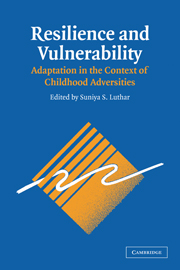Book contents
- Frontmatter
- Contents
- List of Contributors
- Foreword by Dante Cicchetti
- Preface
- 1 A Resilience Framework for Research, Policy, and Practice
- PART I FAMILIAL ADVERSITIES: PARENTAL PSYCHOPATHOLOGY AND FAMILY PROCESSES
- PART II EXOSYSTEMIC AND SOCIODEMOGRAPHIC RISKS
- 10 Rethinking Resilience: A Developmental Process Perspective
- 11 Poverty and Early Childhood Adjustment
- 12 Emerging Perspectives on Context Specificity of Children's Adaptation and Resilience: Evidence from a Decade of Research with Urban Children in Adversity
- 13 Holistic Contextual Perspectives on Risk, Protection, and Competence among Low-Income Urban Adolescents
- 14 Overcoming the Odds? Adolescent Development in the Context of Urban Poverty
- 15 Adaptation among Youth Facing Multiple Risks: Prospective Research Findings
- 16 Positive Adaptation among Youth Exposed to Community Violence
- 17 Perceived Discrimination and Resilience
- 18 Promoting Resilience through Early Childhood Intervention
- PART III COMMENTARIES
- Index
- References
10 - Rethinking Resilience: A Developmental Process Perspective
Published online by Cambridge University Press: 05 June 2012
- Frontmatter
- Contents
- List of Contributors
- Foreword by Dante Cicchetti
- Preface
- 1 A Resilience Framework for Research, Policy, and Practice
- PART I FAMILIAL ADVERSITIES: PARENTAL PSYCHOPATHOLOGY AND FAMILY PROCESSES
- PART II EXOSYSTEMIC AND SOCIODEMOGRAPHIC RISKS
- 10 Rethinking Resilience: A Developmental Process Perspective
- 11 Poverty and Early Childhood Adjustment
- 12 Emerging Perspectives on Context Specificity of Children's Adaptation and Resilience: Evidence from a Decade of Research with Urban Children in Adversity
- 13 Holistic Contextual Perspectives on Risk, Protection, and Competence among Low-Income Urban Adolescents
- 14 Overcoming the Odds? Adolescent Development in the Context of Urban Poverty
- 15 Adaptation among Youth Facing Multiple Risks: Prospective Research Findings
- 16 Positive Adaptation among Youth Exposed to Community Violence
- 17 Perceived Discrimination and Resilience
- 18 Promoting Resilience through Early Childhood Intervention
- PART III COMMENTARIES
- Index
- References
Summary
Children's talent to endure stems from their ignorance of alternatives
(Maya Angelou, 1969)INTRODUCTION
A central tenet of contemporary developmental psychopathology is that our understandings of normative and abnormal development mutually inform one another (Cicchetti, 1990, 1993; Cicchetti & Cohen, 1995; Sroufe & Rutter, 1984). Historically, however, research has focused on the determinants of psychopathology and maladaptation to the relative exclusion of elucidating factors that contribute to the initiation and maintenance of adaptive developmental pathways. More recently, a strong and growing literature has emerged identifying factors that enable individuals to achieve adaptive developmental outcomes despite adversity.
The study of risk and resilience derived from the observation that some individuals in populations exposed to incontrovertible adversity nevertheless achieve adaptive developmental outcomes (e.g., Garmezy, 1974; Murphy & Moriarty, 1976; Rutter, 1979; Sameroff & Seifer, 1983; Werner & Smith, 1992). These individuals exemplify resilience, “the process of, capacity for, or outcome of successful adaptation despite challenging or threatening circumstances” (Masten, Best, & Garmezy, 1990, p. 426). Over the past 25 years, research on a variety of at-risk populations has identified factors that moderate the relation between risk and competence, namely, protective and vulnerability factors (Masten & Coatsworth, 1998). More recently, however, increasing attention has been directed toward identifying and refining the methodological and theoretical frameworks within which resilience is conceptualized and studied in order to clarify the processes that underlie adaptive development in the context of adversity (e.g., Luthar, Cicchetti, & Becker, 2000; Sameroff, 2000).
- Type
- Chapter
- Information
- Resilience and VulnerabilityAdaptation in the Context of Childhood Adversities, pp. 243 - 266Publisher: Cambridge University PressPrint publication year: 2003
References
- 131
- Cited by



